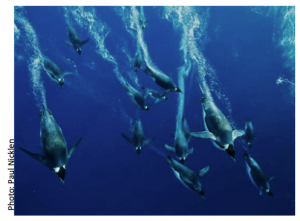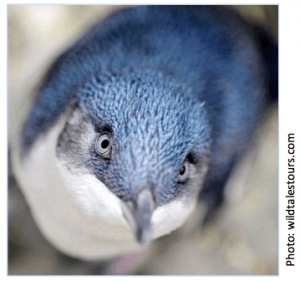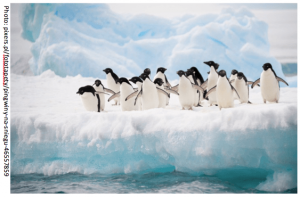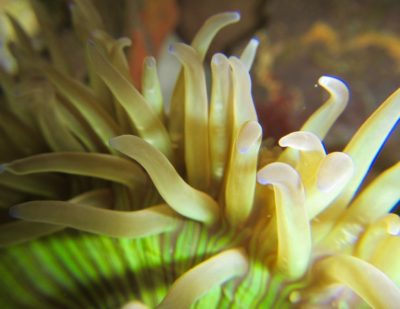Although Wednesday, April 25th is officially World Penguin Day, it’s never a bad day to celebrate these charismatic flightless birds! Penguins’ distinct waddle, fluffy feathers, and stout body shape make them one of the most objectively adorable animals on our planet. But they aren’t just cuddly organisms. On the contrary, they are efficient predators and are resilient in the face of some of the most challenging climates on earth.
 Out of the 17 species in the penguin family, one of the most well-known is the Emperor Penguin. The largest of all penguins, Emperors live year-round in arguably the most unforgiving environment on our planet: the Antarctic. To survive in temperatures as low as -76°F, Emperors live socially, partitioning duties to ensure the continuity of their species. After laying a single egg, females will embark on a two-month journey in search of prey. During their hunting trip, these females will dive down to 1,850 feet for as long as 20 minutes in search of fish, squid and krill. They are aided by their dense bones and stiff flippers, which make flying impossible, but allow the Emperors to dive and swim with high efficiency. Meanwhile, males of the flock remain huddled together for warmth, carefully protecting their female’s egg. These males will rotate through outer and inner positions in the flock, allowing some to warm up in the middle while others bear the brunt of the cold in the outer flanks. Upon the females’ return, they will regurgitate food for their newborn chicks, and the males will swap out, now having their chance to take to the ocean in search of food. Without the cooperative tendencies that Emperor Penguins have developed over thousands of evolutionary years, their species would be long gone in such a trying environment.
Out of the 17 species in the penguin family, one of the most well-known is the Emperor Penguin. The largest of all penguins, Emperors live year-round in arguably the most unforgiving environment on our planet: the Antarctic. To survive in temperatures as low as -76°F, Emperors live socially, partitioning duties to ensure the continuity of their species. After laying a single egg, females will embark on a two-month journey in search of prey. During their hunting trip, these females will dive down to 1,850 feet for as long as 20 minutes in search of fish, squid and krill. They are aided by their dense bones and stiff flippers, which make flying impossible, but allow the Emperors to dive and swim with high efficiency. Meanwhile, males of the flock remain huddled together for warmth, carefully protecting their female’s egg. These males will rotate through outer and inner positions in the flock, allowing some to warm up in the middle while others bear the brunt of the cold in the outer flanks. Upon the females’ return, they will regurgitate food for their newborn chicks, and the males will swap out, now having their chance to take to the ocean in search of food. Without the cooperative tendencies that Emperor Penguins have developed over thousands of evolutionary years, their species would be long gone in such a trying environment.

While Emperors tough out long winters in the Antarctic, every other species of penguin either leaves during the coldest months, or simply occupies a milder climate year-round. The smallest of all penguins, reaching an average of 13 inches in height, is the Little Blue Penguin, which can be found along the coasts of Australia, New Zealand, and Tasmania. Unlike the Emperor Penguin, Little Blues dive in short spurts of about 35 seconds at a time, reaching a maximum depth of 230 feet. But although Little Blues are small, they are mighty. Little Blues have been known to escape from their primary natural predators: skuas, gulls, and sheathbills. Unfortunately, human-sustained predators like rats, dogs, and cats have taken their toll on Little Blue numbers.
Anthropogenic threats to penguins don’t end with predation on Little Blues. Perhaps the most imposing issue for these flightless birds is global climate change. As air and water temperatures warm in the Antarctic, vital ice sheet breeding grounds that Emperor and Adelie penguins need are melting away. A study conducted by the World Wildlife Foundation in 2008 predicted that in 40 years, 50% of Emperor penguins could be wiped out due to the impacts of climate change.

So, what can you do to help out our feathery friends on the other side of the globe? Well, start by celebrating World Penguin Day! Then, think of ways that you can reduce your carbon footprint in order to slow global climate change. Maybe try biking to your friend’s house instead of catching a ride, or reducing the amount of meat you eat! Any little effort helps, because just like the Emperor penguin, if we all work together, we can ensure the continuity of an entire species!
Sources:
https://www.bas.ac.uk/about/antarctica/wildlife/penguins/
https://www.nationalgeographic.com/animals/birds/e/emperor-penguin/


